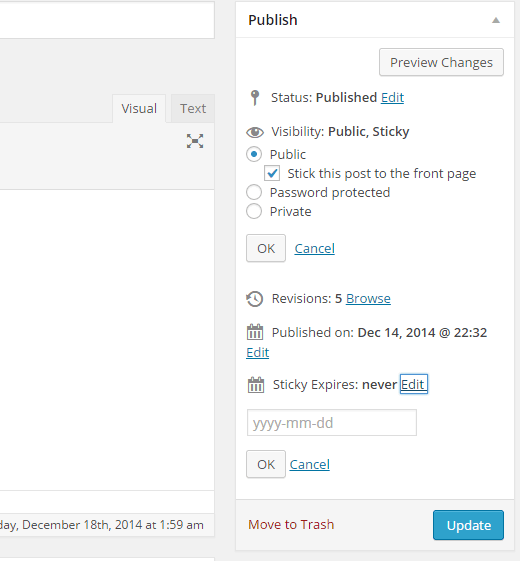I’ve been skimming through the web for some awesome WordPress content. I’ve been using WordPress for 7 years and have installed the platform on hundreds of clients’ websites and “5†of my personal sites. I haven’t paid much attention to some of the cool features they’ve incorporated into the platform with and without plug-ins. For example, just recently, I decided to skim through a website I visit 2-3 times a week because it caters to people interested in learning about WordPress. Many of you probably visit the blog, here’s the name: wpbeginner.com. It’s a cool blog with awesome content always creating a buzz and NOT to mention, it’s definitely an authority! Just check out their social profiles: Twitter (114K) (Facebook 45, 214) (Google + 17, 457). Next,
I’m new to the concept of sticky posts and just started to use them on one of my new niche blogs. When I came across this post, I knew it would be interesting to read and breakdown for all of you guys. This is just a quick overview and if you guys are looking for a more in-depth reference, then read the original here.
Sticky for Custom Post Types
I wasn’t aware of this option and was quite surprised to find this option. With so many new and improved themes available to WordPress users, it only makes sense to have this option. Bloggers can create different posts types other than the default ones already available like:
- Post
- Page
- Attachment
- Revision
- Nav Menu
Adding this simple plug-in will allow you to create a sticky post for custom post types created by you. For example, the content refers to how themes are incorporating “portfolio†as a format now. This plug-in will allow you to publish content and choose default or custom “posts types†to stick the post on top.
Set Them to Expire
As mentioned, I didn’t even know this option existed and I am glad it does. I like to schedule posts because I have a lot of content and with my side projects, I sometimes forget what I have to tweak. However, with this option available, NOT only can I schedule posts, but I can also have sticky posts set to expire automatically. The option is very simple to configure…
Start by installing the “Expire Sticky Post†plug-in and the option will appear under the “Publish†column on the right side bar. Once expiry is set, click “Updateâ€.

(Source: WPBeginner.com)
Sticky Based On Categories
If you’re a blog with a handful of categories, then make use of the “Sticky Post Category†plug-in. With this plug-in, you can configure each category to have its own featured sticky post. Here are some other cool features…
- Easily select what category to display sticky post
- Fully localized for translation
- Customize how it will appear
- Single sticky per category
Overall, it’s an awesome plug-in and the ease of the configuration is cool. If you have several categories on your blog, then this option is perfect for you.
Wrapping It Up…
Altogether, there are “6†cool sticky post customizations you can make, but the “3†listed above are the most common for bloggers. How you use the “sticky†option will depend on your blog and how you want to engage your visitors. For example, if your blog just published a resource list outlining popular content across the web, then you might want to stick this post to the top of the front page or category. On my new blog catering to the “education†niche, I have compiled a list of 50-60 tests and created an ultimate post. This content is a sticky post on my front page with NO expiry date so visitors can quickly find the educational resources they are looking for.
